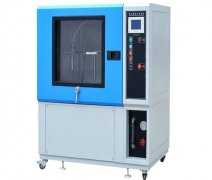Test method of moisture permeability tester for medical protective clothing
The moisture permeability tester is used to test the moisture permeability of various coated fabrics, composite fabrics, composite films, plastic films, exchange films and other materials, and is often used to test medical protective clothing.
Test method for moisture permeability of protective clothing:
1. water vapor transmission method
1.1.1 positive cup method
A, Chinese national standard: GB/T12704-91 B
B, American society for testing materials standard: ASTM E96 Produce B and D
C, Japanese industrial standard: JIS L-1099 A2
D, Canadian Standard: (CGSB)-4.2 No.49-99
E, British standard: BS 7209-1990
1.1.2 cup pouring method (also called moisture absorption method)
A, ASTM E96 BW(1995 and 2000 editions).
1.2 desiccant method
1.2.1 positive cup method
A, Chinese national standard: GB/T 12704-91 A
B, Japanese industrial standard: JIS L-1099 A1
C, ASTM E-96 A, c, e.
1.2.2 method of pouring cups
A, Japanese industrial standards: JIS L-1099 B1, B2
B, American Society for Testing and Materials Standard: ASTM E-96
C, Belgium UCB company standard: UCB method
D, British standard: B.T.T.G method
2, sweating hot plate method, also known as skin model method
A, ISO standard: ISO 11092
B, fire protection clothing test: NFPA 1971
C, American society for testing and materials standard: ASTM F 1868-98 B
D, German standard: DIN 54 010 T01-A
3. Sweating Dummy Method Sweating Dummy Method is a bit like a hot plate, which is used to simulate the shape and size of a typical human body. Dummy test has more practical significance than sweating hot plate test, because it can consider more variables, including the surface area covered by clothing, the number of layers of textiles and the distribution of air layer on the surface of human body, loose or tight fit, skin temperature difference of different parts of human body, body position and movement state, etc. However, no sweat dummy can test the heat of vaporization resistance under dynamic conditions such as walking. At present, there are no design standards and test procedures for sweaty dummies. Moreover, because sweating dummy is more complex and expensive, the test cost of dummy is higher than that of hot plate method.
Other methods a, Watkins method b, Mernander method c, Farnworth method d, Van Beest method e, Ruchman method f, Gibson method.

Meet the standards:
JIS L1099、GB/T 12704
Technical parameters:
1. Temperature range: 20 ~ 60℃
2. Humidity range: 40 ~ 95% (under no load)
3. Temperature accuracy: 0.5℃ (no load)
4. Humidity accuracy: 3% (under no load)
5. Refrigerator: air-cooled closed compression mode
6. cooler: fin cooler
7. Humidifier: pot humidifier (equipped with empty burning preventer)
8. Heater: fin radiator (equipped with over-temperature protector)
9. Blower: fan (one above and one below)
10. Wind speed adjustment range: 0.5~1.5m//s
11. rotating frame: upper and lower sections (270mmφ)
Product application:
1. This device is an environmental testing machine developed for testing the moisture permeability of breathable waterproof materials with three functions, namely waterproof, moisture permeability and ventilation, developed for sportswear, especially ski sportswear and mountaineering clothing.
2. The moisture permeability of the clothes worn on the body is due to the difference in temperature and vapor pressure between the water vapor inside the clothes and the outside air caused by sweating, which causes the water vapor inside the clothes to emit to the outside.
3. In this device, in a tank with a certain temperature and humidity, the sample attached to the moisture permeable cup is placed for a certain period of time, and the water vapor passing through the sample is calculated from the increase of the weight of the hygroscopic material (anhydrous calcium chloride), from which the moisture permeability can be obtained.
4. There are upper and lower rotary sample racks inside the device. In order to make the wind blow to the sample in parallel, a variable wind speed fan is installed corresponding to the two sample racks.
5. This device is also suitable for moisture permeability test of moisture-proof packaging materials.
Technical features:
1. The refrigeration system adopts Taikang refrigeration unit in France to ensure the stable operation of the whole machine for a long time;
2. Adopt the temperature and humidity sensor imported from Switzerland to ensure the accuracy of temperature and humidity in the experimental cabin;
3. Use industrial color touch screen to operate and display Chinese and English menus;
4. Adopt automatic water adding function, which is convenient for testing and suitable for long-time testing;
5. The temperature and humidity recorded once every minute can be queried in real time, and can be printed and output by a printer;
6. Three layers of sample placing racks with 9 test cups on each layer are adopted, which greatly increases the number of single test samples, reduces the operating cost of users and improves the efficiency;
7. The sample taking cups are respectively provided with small doors, which reduces the time for taking samples and the impact on the test environment after opening the doors, and shortens the re-stabilization time;
8. In full compliance with the provisions of Article 5.1.1 of GB/T 12704 ~ 2009, the balance must be reached again within 3 minutes after closing the test hatch;
9. The rotary sample placing rack is more uniform than the fixed sample rack.
2021-02-02 18:04
- Related News
What's the difference between a hydraulic oil filter and a regular oil filter?
Interpretation of Paper Tear Strength Standards
What is the significance of the LA abrasion test?
What is a UTM machine used for?
What is the principle of a capillary rheometer?
What is the difference between conical and parallel twin-screw extruders?
What is the ISO standard for color fastness?
What is the use of a roundness tester?
The Role of Dust-Proof Robot Protective Clothing
What is the difference between Taber and Martindale abrasion tests?
